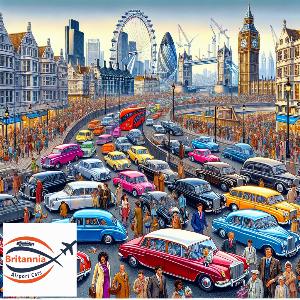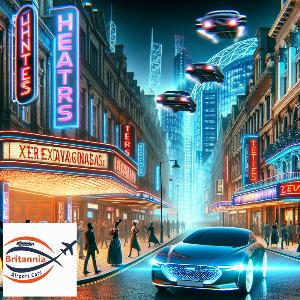Londons Literary Legends: Homes and Hangouts of Famous Writers

Charles Dickens Museum
The Charles Dickens Museum, located in London, is a must-visit for literary enthusiasts. This museum is housed in Dickens' only surviving London residence, where he penned classics like "Oliver Twist" and "Nicholas Nickleby." The museum offers a unique glimpse into the life and times of one of Britain's most celebrated authors. Visitors can explore the writer's study, the family bedchambers, and even the servant's quarters, all meticulously preserved and restored. The museum also boasts a collection of over 100,000 items, including original manuscripts, rare editions, personal items, and artwork, providing an unparalleled insight into Dickens' creative process. Regular exhibitions, workshops, and talks further enrich the visitor experience. The Charles Dickens Museum is not just a tribute to a literary legend, but a testament to the enduring power of his stories. It's a must-see for any literature lover visiting London.
Virginia Woolf's Bloomsbury
Virginia Woolf, a prominent figure in the literary world, was a key member of the Bloomsbury Group, an influential gathering of intellectuals in London. Woolf's Bloomsbury, located in the heart of London, was not just her home but also a hub of literary activity. The area was a melting pot of creativity, where writers, artists, and philosophers would meet to exchange ideas and inspire each other. Woolf's house at 46 Gordon Square was a focal point of this intellectual and artistic activity. It was here that she penned many of her famous works, including 'Mrs. Dalloway' and 'To the Lighthouse'. Today, the spirit of Bloomsbury lives on, with the area still buzzing with literary and artistic energy. A visit to Woolf's Bloomsbury is a must for any literature enthusiast, offering a glimpse into the world of one of London's most celebrated literary legends.
Sherlock Holmes Museum
The Sherlock Holmes Museum, located at 221b Baker Street, is a must-visit for fans of London's literary legends. This Victorian-era townhouse, though not the actual residence of Sir Arthur Conan Doyle's famous detective, is meticulously curated to resemble Holmes' fictional home. As you step inside, you're transported back to the late 19th century, surrounded by period furnishings, Holmes' violin, Dr. Watson's medical bag, and countless other details from the beloved stories. The museum also houses a collection of memorabilia, including first editions and letters written by Conan Doyle. The Sherlock Holmes Museum not only pays homage to one of literature's most iconic characters, but also offers a fascinating glimpse into Victorian London. Whether you're a die-hard Holmes fan or simply a literary enthusiast, this museum is a captivating stop on any literary tour of London.
Samuel Johnson's House
Samuel Johnson's House, located in the heart of London, is a significant landmark in the city's literary history. This charming 17th-century townhouse was the residence of the eminent writer and lexicographer, Samuel Johnson, who compiled the first comprehensive English Dictionary. Today, it stands as a museum, offering a glimpse into Johnson's life and works. The house, with its period furnishings and a collection of artefacts, transports visitors back to the 18th century. It also hosts a library containing first editions of Johnson's works and letters. The house's tranquil garret, where Johnson and his team worked tirelessly on the dictionary, is a highlight. This literary shrine is not just a monument to Johnson's genius but also a testament to London's rich literary heritage. It is a must-visit for literature enthusiasts exploring the homes and hangouts of London's famous writers.
Keats House
Keats House, located in Hampstead, London, is a literary landmark that once served as the home of renowned Romantic poet John Keats. This regency villa is where Keats penned some of his most famous works, including 'Ode to a Nightingale'. Today, it stands as a museum dedicated to his life and work, offering a unique insight into the poet's world. The house is beautifully preserved, with rooms decorated in period style, showcasing personal belongings and original drafts of his poetry. The garden, where Keats found much of his inspiration, is a tranquil oasis, echoing the beauty found in his verses. Keats House is not just a must-visit for literature enthusiasts, but also for anyone interested in delving into the past and experiencing the environment that nurtured one of England's greatest literary talents. It is a testament to London's rich literary heritage and the enduring legacy of its famous writers.
George Orwell's London
George Orwell, one of the most influential writers of the 20th century, left an indelible mark on London's literary landscape. His residence at 27b Canonbury Square in Islington is a site of pilgrimage for many literature enthusiasts. It was here that Orwell penned his dystopian masterpiece, '1984'. The flat, marked by a blue plaque, is a testament to Orwell's austere lifestyle and his commitment to writing. Orwell's London was not just confined to his home. He frequented many local pubs, including The Wheatsheaf in Rathbone Place and The Newman Arms in Fitzrovia, which are believed to have inspired the 'Proles Pub' in '1984'. These establishments offer a glimpse into the writer's life and the city that shaped his work. Orwell's London is a fascinating journey through the streets that influenced one of the greatest literary minds, making it a must-visit for any literature lover.
Agatha Christie's London
Agatha Christie, the queen of mystery, has left an indelible mark on London's literary landscape. Born in Torquay in 1890, Christie spent significant periods of her life in the capital, drawing inspiration from its bustling streets and tranquil parks. Her residence at 58 Sheffield Terrace in Kensington is a must-visit for fans, where she penned classics like "Death on the Nile" and "And Then There Were None". Another notable haunt was the legendary Brown's Hotel in Mayfair, where she wrote "At Bertram's Hotel". The hotel still pays homage to Christie with a special afternoon tea. The capital's influence is evident in her works, with many of her stories set in London. From the British Museum in "The Adventure of the Egyptian Tomb" to the iconic King's Cross Station in "The Mystery of the Blue Train", Christie's London is a captivating blend of fact and fiction, making it an essential stop on any literary tour.
Oscar Wilde's London
Oscar Wilde, the flamboyant Irish playwright and poet, left an indelible mark on London's literary scene. His London life was centered around Chelsea, where he resided at 34 Tite Street. This elegant townhouse, now adorned with a blue plaque, was the setting for his prolific writing career and extravagant social life. Wilde's wit and charm also dominated the city's social circles. He was a regular at the Café Royal on Regent Street, a popular haunt for artists and intellectuals, where he often held court. The Savoy Hotel was another favorite spot, particularly its private dining room, where he hosted the infamous 'Wilde's Suppers'. His plays, including 'The Importance of Being Earnest', were performed at the St. James's Theatre, making it a significant landmark in Wilde's London. Despite his tragic end, Oscar Wilde's spirit continues to permeate through these iconic London locales, making them must-visit spots for any literary enthusiast.
J.M. Barrie's Kensington Gardens
J.M. Barrie, the Scottish novelist and playwright best known for creating Peter Pan, found his inspiration in London's Kensington Gardens. Barrie moved to London in the late 19th century and became a regular visitor to the gardens. He would often write and observe children playing, which led to the creation of his most famous character. The gardens are even directly referenced in his works, with Peter Pan famously residing in Kensington Gardens in the story. Today, a statue of Peter Pan stands in the gardens, a tribute to Barrie and his timeless creation. The statue was commissioned by Barrie himself and placed there in 1912. For literature lovers, a visit to Kensington Gardens is a must. Not only can you enjoy the beautiful scenery, but you can also walk in the footsteps of one of London's literary legends.
Shakespeare's Globe Theatre
The Globe Theatre, an iconic landmark in London, is a testament to the literary genius of William Shakespeare. This open-air playhouse, situated on the south bank of the River Thames, was where Shakespeare's most famous plays were first staged. The original structure, built in 1599, was unfortunately destroyed by fire in 1613. A second Globe was quickly erected on the same site, only to be closed in 1642 and demolished in 1644. Today's Globe, a faithful reconstruction of the original, opened in 1997 and continues to celebrate Shakespeare's legacy. Visitors can experience the thrill of Elizabethan theatre, standing as 'groundlings' in the open yard or sitting in the wooden galleries. The Globe is not just a theatre but a window into the world of the Bard. It is a must-visit for any literary enthusiast, offering a tangible connection to the life and works of one of the world's greatest writers.
Our Latest Blog Posts

Cultural Delights: Londons Top Galleries and Exhibitions
Blog about Cultural Delights: Londons Top Galleries and Exhibitions
Read More
The West End Extravaganza: A Guide to Londons Theatre Scene
Blog about The West End Extravaganza: A Guide to Londons Theatre Scene
Read More
Funky Flea Markets: Vintage Finds and Treasures in London
Blog about Funky Flea Markets: Vintage Finds and Treasures in London
Read More
Budget-Friendly London: Explore the City Without Overspending
Explore London on a budget! Discover top attractions, dining, and travel tips for an affordable yet unforgettable experience in the city.
Read More
Londons Sporting Scene: From Football Matches to Wimbledon
Blog about Londons Sporting Scene: From Football Matches to Wimbledon
Read More
Mystical Markets: Psychic and Alternative Fairs in London
Blog about Mystical Markets: Psychic and Alternative Fairs in London
Read More
DIY Walking Tours: Crafting Your Own London Adventure
Blog about DIY Walking Tours: Crafting Your Own London Adventure
Read More
Rooftop Revelry: Sky-High Bars and Views Across London
Blog about Rooftop Revelry: Sky-High Bars and Views Across London
Read More
Bridges of London: Crossings with a View and History
Blog about Bridges of London: Crossings with a View and History
Read More
Londons Literary Escapes: Bookish Cafés and Libraries
Blog about Londons Literary Escapes: Bookish Cafés and Libraries
Read More
Urban Nature: Wildlife Encounters in Londons Parks
Blog about Urban Nature: Wildlife Encounters in Londons Parks
Read More
Navigating London Airport Minicabs: A Comprehensive Guide for First-Time Travelers
Blog about Navigating London Airport Transfers: A Comprehensive Guide for First-Time Travelers
Read More
Architectural Wonders: A Tour of London’s Iconic Buildings
Explore London’s architectural wonders with a tour of modern and historic buildings. Discover the city’s iconic landmarks and stunning structures.
Read More
Feast and Fables: Londons Historic Foodie Hotspots
Blog about Feast and Fables: Londons Historic Foodie Hotspots
Read More
Winter Wonderland: Ice Skating and Festivities in London
Blog about Winter Wonderland: Ice Skating and Festivities in London
Read More
Londons Vintage Cinemas: Classic Movies and Old-School Charm
Blog about Londons Vintage Cinemas: Classic Movies and Old-School Charm
Read MoreBlog Posts
- Londons Festive Markets: Holiday Shopping Extravaganza
- Local Legends: Stories and Myths Behind Londons Landmarks
- Londons Diverse Flavors: Exploring International Cuisine
- Museum Marathons: A Day of Art and Culture in London
- The Regal Route: Touring Londons Castles and Historic Reside
- Understanding London Airport Minicabs: Making Your Journey E
- Navigating London Airport Minicabs: A Comprehensive Guide fo
- London Calling: Ultimate Travel Itinerary for Your Trip
- Cycle City: Biking Adventures and Trails in London
- Londons Multicultural Melting Pot: Ethnic Enclaves and Festi
- London Seaports Taxi Transfer
- Chasing Rainbows: Londons LGBTQ+ History and Pride Celebrati
- Seaside Escapes: Beaches and Coastal Getaways Near London
- Demystifying London Airport Transfers – A Traveler&rsq
- Londons Musical Melodies: From Abbey Road to Iconic Concert
- Culinary Adventures: Londons Best Food Markets and Festivals
